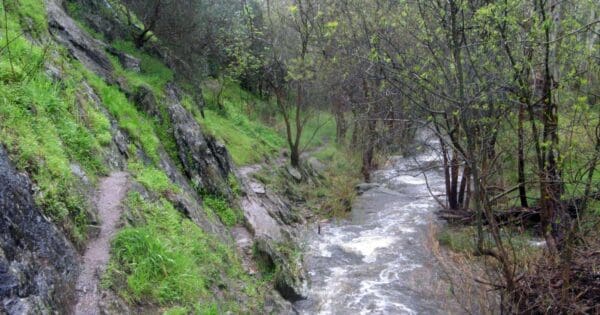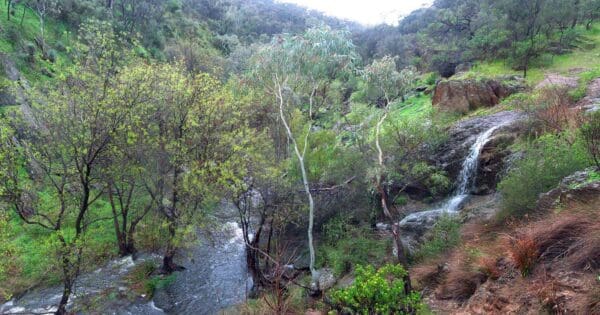There are excellent shady cuttings, underpasses, original embankments and bridges
The Coast to Vines trail is a great day or weekend destination on the Fleurieu Peninsula
The track has a sealed surface for most of the distance
Gradients are gentle, except where some bypasses go around old bridge sites
From Marino Rocks Station, the trail runs south beside the railway to Hallett Cove. It is a bit undulating, but frequent stops will be needed to take in the ocean views.
From here the trail is a wide, well vegetated reserve through the suburbs linking together other conservation reserves and parks.
Major road crossings have traffic islands or lights.
Marino Rocks Railway Station to Willunga former station site in Station Rd
Marino Rocks to Willunga in Regional South Australia
Southern Adelaide Suburbs
Sealed
Photo credit: Rail Trails Australia. For more information and a location map please visit RailTrails Australia.
Grade 4 (Hard) -
Challenging Walks for Experienced Walkers: Grade 4 on the
AWTGS signifies challenging walking tracks. Bushwalking experience is recommended for these tracks, which may be long, rough, and very steep. Directional signage may be limited, requiring a good sense of navigation. These walks are suited for experienced walkers who are comfortable with steeper inclines, rougher terrain, and potentially longer distances.
Do you have a GPX file for this hike? Feel free to email it to me so I can add it to this hikes info.
Click to add your file >>
Content use
Please don’t copy GPX files or content from this site to AllTrails or other platforms. Each trail has been personally mapped, documented, and refined to support Australia’s bushwalking and hiking community. While some details come from land managers, every listing reflects significant personal effort. This is a free, community-driven initiative—your respect helps keep it that way.
Gallery
Got any photos from this hike? Your photos can help others plan. Share shots from along the trail so fellow hikers know what to expect.
Click to add your photos >>
About the region
South Australia has made a name for itself as a relaxed region full of wine, wildlife and natural wonder. Its capital of Adelaide is home to a sophisticated art and dining scene, and the Festival City' knows how to celebrate, with a calendar full to the brim with events. Beyond the capital city, undulating wine regions produce classic Australian drops, migrating whales glide along rugged coastline and koalas snooze among the treetops on wind-swept islands.
Find a place to stay
Wondering where to stay near this hike? Find accommodation close to the trailhead — hotels, cabins and campgrounds nearby. Click the button to view the interactive map.
Closest towns to this walk: Berri, Bordertown, Clare, Gawler, Loxton, Millicent, Mount Gambier, Mount Pleasant, Murray Bridge, Naracoorte, Penola, Peterborough, Port Augusta, Port Lincoln, Port Pirie, Renmark, Strathalbyn, Whyalla
Let someone know
Heading out? Fill in a trip intentions form so someone knows your plans. If things go wrong, they can raise the alarm fast, giving you peace of mind on the trail.
Similar walks nearby
Looking for more walks in or near Regional South Australia? Try these trails with a similar difficulty grade.
Favourite

Favourite

Sturt Gorge Recreation Park
Favourite

Sturt Gorge Recreation Park
Favourite

Sturt Gorge Recreation Park
Suggest an edit
Notice something different about this trail? Whether it’s a new feature, a route change, or a closure, share your update so we can keep our info accurate and helpful for fellow hikers.
Click to suggest edits >>
Explore safe
Plan ahead and hike safely! Carry enough water, pack layers for changing conditions, and bring safety gear like a torch, PLB, and reliable communication device. Check official sources for trail updates, closures, and access requirements, and review local weather and bushfire advice. Most importantly, share your plans with someone before you go. Being prepared makes for a safer and more enjoyable hike! Stay Safe, Explore More, and Always #ExploreSafe.
Packing checklists
What you carry in your pack depends on factors like weather, terrain, and your adventure type. Not sure what to bring? My free planning, food, and packing checklists are a great starting point, covering day hikes, overnight trips, and multi-day adventures. Use them to customise your kit and always prioritise safety.







4 Reviews on “Coast to Vines Rail Trail Walk (37km)”
Can I catch train